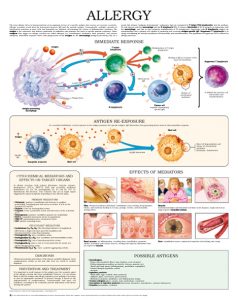Allergy (II)

[hfe_template id=’14716′]
[hfe_template id=’16832′]
The term allergy refers to hypersensitivity of an organism in face of a specific antigen that causes an excessive reactivity. Allergic reactions result from the interaction between IgE and the specific antigen. Consequently, multiple cascades of biochemical reactions in mast cells and basophils are initiated, determining the release of inflammation cytokines. The antigen is the substance that induces production of antibodies and promotes the onset of specific immune responses. Those antigens that trigger an allergic reaction are called allergens (i.e. aeroallergens, medicines, food, parasites, and contact allergens). Immediate response starts with phagocytosis of the antigen by the macrophage (antigen-presenting cell). As a result, this releases “antigenic determinants” -substances that are recognized by T helper (Th) lymphocytes- into the medium. Th cells interact with the macrophage and the B lymphocyte (BL). It releases interleukin 1 (IL-1) owing to its interaction with the macrophage, and this in turn promotes multiplication of Th lymphocytes. Interaction with B lymphocyte triggers its transformation into a plasma cell capable of producing and secreting antigen-specific IgE. Suppressor T lymphocyte is in charge of inhibiting the already mentioned cell interactions and transformations. The population of suppressor TLs is reduced in allergic processes.
